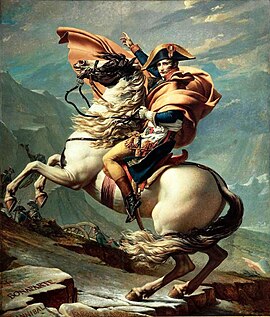Napoleon Leading the Army over the Alps
This article includes a list of references, related reading, or external links, but its sources remain unclear because it lacks inline citations. (July 2015) |
Napoleon Leading the Army over the Alps is an equestrian portrait of a youthful black male painted by the contemporary artist Kehinde Wiley in 2005. It is based on Jacques-Louis David’s 1801 equestrian portrait, Bonaparte Crossing the Alps. This painting was chosen by a man who Kehinde had approached in the streets. The basic composition of Wiley's painting is the same as the 200-year-old painting it was based on, and has many of the same elements. The modern painting has a decorative background rather than the battlefield background.
Background
This painting is very typical of the style of Kehinde Wiley in that it is a monumental painting that incorporates brocade/decorative motif as an element of the background. Many of Kehinde Wiley’s paintings, like Napoleon Leading the Army, begin when he approaches a youthful black man in the streets (often from inner cities in the U.S.) and asks them to model for him. Kehinde then asks them to choose a painting from art history books for their portrait, and photographs them in the appropriate pose before beginning the actual painting, just as he probably did with the man who modeled for Napoleon Leading His Army.[1]
Description of the Painting
The subject is a youthful black man in fashionable street wear mounted on a rearing horse and pointing upwards. The man has tattoos on his right arm and is dressed in a camouflage shirt and cargo pants. He has a voluminous golden cloak and a saber attached at his waist. He also wears Timberland boots, Starter wristbands, and a white and black bandana.[2] The painting has a decorative, Baroque motif that looks very much like wallpaper in the painting’s background but also interrupts the foreground a bit, as the motif is painted in front of some of the rocks. This flattened background clashes with the “photo-realist rendering” of the subject.[3] The rocky surface that serves as the ground of the painting has names engraved in the bottom left corner of the painting. The names are: Williams (perhaps the name of the subject), Bonaparte, Hannibal, and Charlemagne. There are small sperm cells “swimming” over the whole canvas. The whole painting is set in an elaborate gold colored frame, just as many European portraits of rulers were framed.
Similarities Between the Two Paintings
| Napoleon Crossing the Alps | |
|---|---|
 | |
| Artist | Jacques-Louis David |
| Year | 1801 |
| Type | Oil on canvas |
| Dimensions | 261 cm × 221 cm (102+1⁄3 in × 87 in) |
| Location | Château de Malmaison, Rueil-Malmaison |
The basic composition of Wiley’s painting is the same as the composition of the David painting it was based on, and has many of the same elements. The black male assumes the same pose as Napoleon does, with the same confidence in their face and body language. Napoleon wears the uniform of a general in the painting by David, and while the black male is wearing fashionable street clothing, the camouflage pants and shirt have associations with the military, especially combined with the sword around his waist. In both, there is a deliberate contrast between the confidence and calmness of the subject’s expression and the rearing horse’s flaring nostrils and wide eyes. Both of the paintings have the names of other military leaders who had taken their armies over the Alps as if they were carved into the mountain’s rocky side, with the subject’s names among them, asserting them as their equals. Just as David signed and dated his painting on the horse’s breastplate, so does Wiley, using Roman numerals.[4]
Just as Kehinde’s subject did not sit for the portrait, neither did Napoleon sit for David, but rather sent instructions that he should be depicted “‘calm on a spirited horse.’”[5]
Notes
References
Banks, Andre. "NO POSER HERE; Acclaimed Artist Kehinde Wiley Paints Black Masculinity Anew." Colorlines 8, no. 4 (Winter 2006): 57.
Lenzi, Carlotta. "Jacques-Louis David: Artistic Interpretation in Tumultuous Times." (2008).
Munhall, Edgar. "Portraits of Napoleon." Yale French Studies no. 26, The Myth of Napoleon (1960): 3-20.
Shareef, Shahrazad A. "The Power of Decor: Kehinde Wiley's Interventions into the Construction of Black Masculine Identity." UMI Dissertations Publishing (2010).
External links
Branch, Matthew and Alexa Fairchild. "Brooklyn Museum Teaching Source: Kehinde Wiley. Napoleon Leading the Army Over the Alps." Brooklyn Museum. [1]
“Napoleon Leading the Army over the Alps.” Brooklyn Museum. [2]
"Kehinde Wiley FAQ." Kehinde Wiley Studio. [3]
